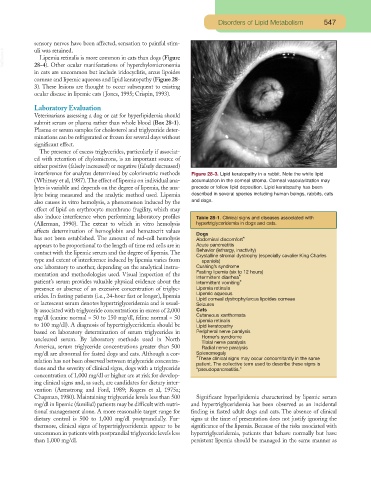Page 529 - Small Animal Clinical Nutrition 5th Edition
P. 529
Disorders of Lipid Metabolism 547
sensory nerves have been affected, sensation to painful stim-
VetBooks.ir uli was retained.
Lipemia retinalis is more common in cats than dogs (Figure
28-4). Other ocular manifestations of hyperchylomicronemia
in cats are uncommon but include iridocyclitis, arcus lipoides
corneae and lipemic aqueous and lipid keratopathy (Figure 28-
3). These lesions are thought to occur subsequent to existing
ocular disease in lipemic cats (Jones, 1995; Crispin, 1993).
Laboratory Evaluation
Veterinarians assessing a dog or cat for hyperlipidemia should
submit serum or plasma rather than whole blood (Box 28-1).
Plasma or serum samples for cholesterol and triglyceride deter-
minations can be refrigerated or frozen for several days without
significant effect.
The presence of excess triglycerides, particularly if associat-
ed with retention of chylomicrons, is an important source of
either positive (falsely increased) or negative (falsely decreased)
interference for analytes determined by colorimetric methods Figure 28-3. Lipid keratopathy in a rabbit. Note the white lipid
(Whitney et al, 1987).The effect of lipemia on individual ana- accumulation in the corneal stroma. Corneal vascularization may
lytes is variable and depends on the degree of lipemia, the ana- precede or follow lipid deposition. Lipid keratopathy has been
lyte being measured and the analytic method used. Lipemia described in several species including human beings, rabbits, cats
also causes in vitro hemolysis, a phenomenon induced by the and dogs.
effect of lipid on erythrocyte membrane fragility, which may
also induce interference when performing laboratory profiles Table 28-1. Clinical signs and diseases associated with
(Allerman, 1990). The extent to which in vitro hemolysis hypertriglyceridemia in dogs and cats.
affects determination of hemoglobin and hematocrit values
Dogs
has not been established. The amount of red-cell hemolysis Abdominal discomfort*
appears to be proportional to the length of time red cells are in Acute pancreatitis
contact with the lipemic serum and the degree of lipemia.The Behavior (lethargy, inactivity)
Crystalline stromal dystrophy (especially cavalier King Charles
type and extent of interference induced by lipemia varies from spaniels)
one laboratory to another, depending on the analytical instru- Cushing’s syndrome
mentation and methodologies used. Visual inspection of the Fasting lipemia (six to 12 hours)
Intermittent diarrhea*
patient’s serum provides valuable physical evidence about the Intermittent vomiting*
presence or absence of an excessive concentration of triglyc- Lipemia retinalis
erides. In fasting patients (i.e., 24-hour fast or longer), lipemia Lipemic aqueous
Lipid corneal dystrophy/arcus lipoides corneae
or lactescent serum denotes hypertriglyceridemia and is usual- Seizures
ly associated with triglyceride concentrations in excess of 2,000 Cats
mg/dl (canine normal = 50 to 150 mg/dl, feline normal = 50 Cutaneous xanthomata
Lipemia retinalis
to 100 mg/dl). A diagnosis of hypertriglyceridemia should be Lipid keratopathy
based on laboratory determination of serum triglycerides in Peripheral nerve paralysis
uncleared serum. By laboratory methods used in North Horner’s syndrome
Tibial nerve paralysis
America, serum triglyceride concentrations greater than 500 Radial nerve paralysis
mg/dl are abnormal for fasted dogs and cats. Although a cor- Splenomegaly
relation has not been observed between triglyceride concentra- *These clinical signs may occur concomitantly in the same
patient. The collective term used to describe these signs is
tions and the severity of clinical signs, dogs with a triglyceride “pseudopancreatitis.”
concentration of 1,000 mg/dl or higher are at risk for develop-
ing clinical signs and, as such, are candidates for dietary inter-
vention (Armstrong and Ford, 1989; Rogers et al, 1975a;
Chapman, 1980). Maintaining triglyceride levels less than 500 Significant hyperlipidemia characterized by lipemic serum
mg/dl in lipemic (familial) patients may be difficult with nutri- and hypertriglyceridemia has been observed as an incidental
tional management alone. A more reasonable target range for finding in fasted adult dogs and cats. The absence of clinical
dietary control is 500 to 1,000 mg/dl postprandially. Fur- signs at the time of presentation does not justify ignoring the
thermore, clinical signs of hypertriglyceridemia appear to be significance of the lipemia. Because of the risks associated with
uncommon in patients with postprandial triglyceride levels less hypertriglyceridemia, patients that behave normally but have
than 1,000 mg/dl. persistent lipemia should be managed in the same manner as

